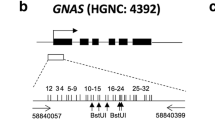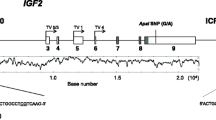Abstract
IGF2 and H19 are imprinted genes in normal human tissue, but many studies have observed a loss of imprinting (LOI) of these genes in tumors as an epigenetic alteration of the DNA, that leads to a biallelic expression predisposing cells to carcinogenesis and tumor growth. The aim of this study was to test the reliability of LightCycler™-assisted Real-time PCR in detecting LOI of IGF2 and H19 in 39 patients with testicular germ cell tumors by comparing these results with the analysis generated by the golden standard restriction fragment length polymorphism (RFLP). With LightCycler™-assisted Real-time PCR for IGF2 44% and for H19 49% of the patients were found to be heterozygous. This was consistent with the results obtained by RFLP, but surprisingly RFLP failed in more than 7% of the patients. In detecting LOI (for IGF2 in 41% and for H19 in 68% of the informative patients) the approach by RFLP was superior, since the results derived from LightCycler™-assisted Real-time PCR showed reliable results in 76 and 10% of the samples concerning IGF2 and H19, respectively. Again, no discrepancy between the results obtained by the two methods occurred. In sum, LightCycler™-assisted Real-time PCR is a sufficiently working approach for the rapid and reliable detection of heterozygosity of IGF2 or H19 gene and identification of LOI of IGF2 and thus may be helpful in conducting large epidemiological studies. However, for the identification of LOI of the H19 gene in this cohort it possesses only restrictive use.




Similar content being viewed by others
References
Brüning T, Abel J, Koch B, Lorenzen K, Harth V, Donat S, Sachinidis A, Vetter H, Bolt HM, Ko Y (1999) Real-time PCR-analysis of the cytochrome P450 1B1 codon 432-polymorphism. Arch Toxicol 73:427–430
Burns JL, Jackson DA, Hassan AB (2001) A view through the clouds of imprinting. FASEB J 15:1694–1703
Chen CL, Ip SM, Cheng D, Wong LC, Ngan HY (2000) Loss of imprinting of the IGF-II and H19 genes in epithelial ovarian cancer. Clin Cancer Res 6:474–479
Christofori G, Naik P, Hanahan D (1994) A second signal supplied by insulin-like growth factor II in oncogene-induced tumorigenesis. Nature 369:414–418
Cui H, Horon IL, Ohlsson R, Hamilton SR, Feinberg AP (1998) Loss of imprinting in normal tissue of colorectal cancer patients with microsatellite instability. Nat Med 4:1276–1280
Cui H, Cruz-Correa M, Giardiello FM, Hutcheon DF, Kafonek DR, Brandenburg S, Wu Y, He X, Powe NR, Feinberg AP (2003) Loss of IGF2 imprinting: a potential marker of colorectal cancer risk. Science 299:1753–1755
DeChiara TM, Robertson EJ, Efstratiadis A (1991) Parental imprinting of the mouse insulin-like growth factor II gene. Cell 64:849–859
Douc-Rasy S, Barrois M, Fogel S, Ahomadegbe JC, Stehelin D, Coll J, Riou G (1996) High incidence of loss of heterozygosity and abnormal imprinting of H19 and IGF2 genes in invasive cervical carcinomas. Uncoupling of H19 and IGF2 expression and biallelic hypomethylation of H19. Oncogene 12:423–430
Fukuzawa R, Umezawa A, Ochi K, Urano F, Ikeda H, Hata J (1999) High frequency of inactivation of the imprinted H19 gene in “sporadic” hepatoblastoma. Int J Cancer 82:490–497
Goodman JI, Watson RE (2002) Altered DNA methylation: a secondary mechanism involved in carcinogenesis. Annu Rev Pharmacol Toxicol 42:501–525
van Gurp RJ, Oosterhuis JW, Kalscheuer V, Mariman EC, Looijenga LH (1994) Biallelic expression of the H19 and IGF2 genes in human testicular germ cell tumors. J Natl Cancer Inst 86:1070–1075
Hao Y, Crenshaw T, Moulton T, Newcomb E, Tycko B (1993) Tumour-suppressor activity of H19 RNA. Nature 365:764–767
Harth V, Donat S, Ko Y, Abel J, Vetter H, Brüning T (2000) NAD(P)H quinone oxidoreductase 1 codon 609 polymorphism and its association to colorectal cancer. Arch Toxicol 73:528–531
Jirtle RL (1999) Genomic imprinting and cancer. Exp Cell Res 248:18–24
Ko Y, Koch B, Harth V, Sachinidis A, Thier R, Vetter H, Bolt HM, Brüning T (2000) Rapid analysis of GSTM1, GSTT1 and GSTP1 polymorphisms using real-time polymerase chain reaction. Pharmacogenetics 10:271–274
Kondo M, Suzuki H, Ueda R, Osada H, Takagi K, Takahashi T (1995) Frequent loss of imprinting of the H19 gene is often associated with its overexpression in human lung cancers. Oncogene 10:1193–1198
Li X, Adam G, Cui H, Sandstedt B, Ohlsson R, Ekstrom TJ (1995) Expression, promoter usage and parental imprinting status of insulin-like growth factor II (IGF2) in human hepatoblastoma: uncoupling of IGF2 and H19 imprinting. Oncogene 11:221–229
Moulton T, Crenshaw T, Hao Y, Moosikasuwan J, Lin N, Dembitzer F, Hensle T, Weiss L, McMorrow L, Loew T et al (1994) Epigenetic lesions at the H19 locus in Wilms’ tumour patients. Nat Genet 7:440–447
Nakagawa H, Chadwick RB, Peltomaki P, Plass C, Nakamura Y, de La Chapelle A (2001) Loss of imprinting of the insulin-like growth factor II gene occurs by biallelic methylation in a core region of H19-associated CTCF-binding sites in colorectal cancer. Proc Natl Acad Sci USA 98:591–596
Narayan S, Roy D (2003) Role of APC and DNA mismatch repair genes in the development of colorectal cancers. Mol Cancer 2:41
Neuhaus T, Geisen G, Bolt HM, Janzen V, Kraemer A, Vetter H, Ko Y (2004) Reliability of non-invasively acquired human genomic DNA as a substrate for real-time PCR assisted analysis of genetic polymorphisms. Arch Toxicol 78(7):390–396
Nonomura N, Miki T, Nishimura K, Kanno N, Kojima Y, Okuyama A (1997a) Altered imprinting of the H19 and insulin-like growth factor II genes in testicular tumors. J Urol 157:1977–1979
Nonomura N, Nishimura K, Miki T, Kanno N, Kojima Y, Yokoyama M, Okuyama A (1997b) Loss of imprinting of the insulin-like growth factor II gene in renal cell carcinoma. Cancer Res 57:2575–2577
O’Dell SD, Day IN (1998) Insulin-like growth factor II (IGF-II). Int J Biochem Cell Biol 30:767–771
Ogawa O, Eccles MR, Szeto J, McNoe LA, Yun K, Maw MA, Smith PJ, Reeve AE (1993) Relaxation of insulin-like growth factor II gene imprinting implicated in Wilms’ tumour. Nature 362:749–751
Ohlsson R, Nystrom A, Pfeifer-Ohlsson S, Tohonen V, Hedborg F, Schofield P, Flam F, Ekstrom TJ (1993) IGF2 is parentally imprinted during human embryogenesis and in the Beckwith–Wiedemann syndrome. Nat Genet 4:94–97
Rainier S, Johnson LA, Dobry CJ, Ping AJ, Grundy PE, Feinberg AP (1993) Relaxation of imprinted genes in human cancer. Nature 362:747–749
Reik W, Murrell A (2000) Genomic imprinting. Silence across the border. Nature 405:408–409
Sandovici I, Leppert M, Hawk PR, Suarez A, Linares Y, Sapienza C (2003) Familial aggregation of abnormal methylation of parental alleles at the IGF2/H19 and IGF2R differentially methylated regions. Hum Mol Genet 12:1569–1578
Schofield PN (1991) Molecular biology of the insulin-like growth factors: gene structure and expression. Acta Paediatr Scand Suppl 372:83–90; discussion 91
Steenman MJ, Rainier S, Dobry CJ, Grundy P, Horon IL, Feinberg AP (1994) Loss of imprinting of IGF2 is linked to reduced expression and abnormal methylation of H19 in Wilms’ tumour. Nat Genet 7:433–439
Thorvaldsen JL, Duran KL, Bartolomei MS (1998) Deletion of the H19 differentially methylated domain results in loss of imprinted expression of H19 and Igf2. Genes Dev 12:3693–3702
Vu TH, Yballe C, Boonyanit S, Hoffman AR (1995) Insulin-like growth factor II in uterine smooth-muscle tumors: maintenance of genomic imprinting in leiomyomata and loss of imprinting in leiomyosarcomata. J Clin Endocrinol Metab 80:1670–1676
Werner H, LeRoith D (1996) The role of the insulin-like growth factor system in human cancer. Adv Cancer Res 68:183–223
Zhan S, Shapiro DN, Helman LJ (1994) Activation of an imprinted allele of the insulin-like growth factor II gene implicated in rhabdomyosarcoma. J Clin Invest 94:445–448
Zhan S, Shapiro DN, Helman LJ (1995) Loss of imprinting of IGF2 in Ewing’s sarcoma. Oncogene 11:2503–2507
Zhang Y, Tycko B (1992) Monoallelic expression of the human H19 gene. Nat Genet 1:40–44
Author information
Authors and Affiliations
Corresponding author
Additional information
Sebastian Stier and Thomas Neuhaus contributed equally to this work.
Rights and permissions
About this article
Cite this article
Stier, S., Neuhaus, T., Albers, P. et al. Loss of imprinting of the insulin-like growth factor 2 and the H19 gene in testicular seminomas detected by real-time PCR approach. Arch Toxicol 80, 713–718 (2006). https://doi.org/10.1007/s00204-006-0087-z
Received:
Accepted:
Published:
Issue Date:
DOI: https://doi.org/10.1007/s00204-006-0087-z




